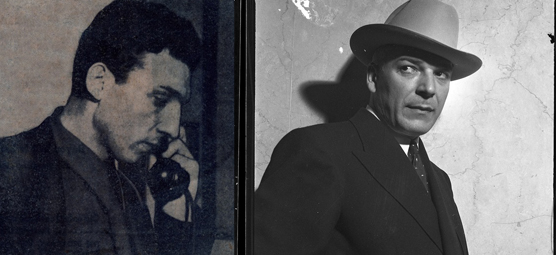Gambler and Underworld Czar Cornero Cut Down at Front Door-September 22

Schroeder and Fogg will revisit celebrity crimes in Beverly Hills as they discuss and sign copies of their book Friday and Saturday, October 4-5. Book signing will be from 12 to 4 p.m. on Friday, October 4, with their Courtroom Presentation set for 1-2 pm. Saturday, October 5, followed by book signing.
Cost is complimentary for Museum Members. Members click here
For non-members, cost is included in purchase of Museum admission. Click here for tickets.
As Beverly Hills was slowly transitioning back into a city of prosperity after World War II, it became a new target for mobsters who had the simple theory: Go where the money is. Turns out mobsters liked living the high life, but they brought some unwelcome drama along with them. Case in point: Anthony “Tony” Stralla, the king of offshore gambling boats and other nefarious Mob activities.
Beverly Hills Police had a constant watch on Tony Cornero. They described him as an “unsavory” character. Cornero was careful not to bring his dangerous vice into the city, but it wasn’t long before it followed him home. At 6:45 p.m. on February 9, 1948, a shot echoed throughout a normally quiet street in Beverly Hills. The target? Tony.
Let’s take you back to the scene of the crime: 312 South Elm Drive, south of Wilshire Boulevard. Tony Cornero is in a meeting with two Mexican businessmen. The doorbell rings; Tony hears someone outside the front door, a man, saying, “Package for you.” Tony opens the door, and two male suspects in their 30s push their way into the house. An argument erupts, then a shot is fired through a box that one of the men was carrying. Tony grasps his stomach and yells for his wife, “Get my gun, quick!”
Tony falls to the ground, and the two suspects start rummaging through his pockets, but they fail to get anything and quickly flee the scene. Tony is transported to Cedars of Lebanon Hospital where doctors work feverishly to save his life. The bullet is believed to have penetrated his liver. Luck is with this gambler and he lives to tell the story, but not the motive. He is evasive with police, offering only a description of his attacker as “a tall, skinny, thin-faced man who looked like Humphrey Bogart.” (How noir!)
Police work the case to find the motive and a suspect. Here’s what they came up with:
Hypothesis I: Tony had failed to divvy up with “investors” money he was making off his ill-fated gambling barge, the “Lux” (which would eventually be seized by the U.S. government).
Hypothesis II: Tony was trying to muscle in on the possible revival of gaming in Baja California. Even Mexican newspapers printed headlines such as: Gambling will be Okayed in Lower California if Cornero is eliminated.
As for a suspect, officers narrowed it down to Herman “Hi” Cutler, a medium big shot from the East Coast with a record as long as a gangster’s memory. (Cutler had quite the history: he’d been the best man at the wedding of gangster “Meatball” Gamson who was shot to death in Beverly Hills not long after his wedding.)
Officers wanted to question Cutler, but never got the chance. Cutler was in a courtroom awaiting a hearing on five charges of check forgery (not connected with the Cornero case). While his lawyer was in chambers with the judge, Cutler told a bailiff, “I’m on the spot now! There’s guys all around me who’d bump me off as soon as they got a look at me. I gotta go!” Cutler took off like a jackrabbit and vanished out of sight before police could take him into custody and ask him key questions or line him up for Cornero to finger the guy who gave him so much grief.
Don’t miss my next blog: How Tony Cornero was just one of three mobsters gunned down in bucolic Beverly Hills.
Feedback or questions? Email blog@themobmuseum.org








